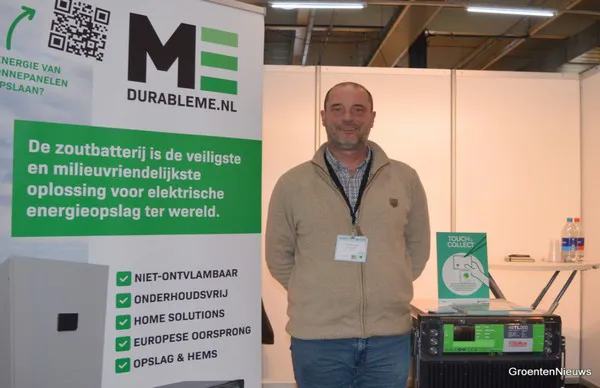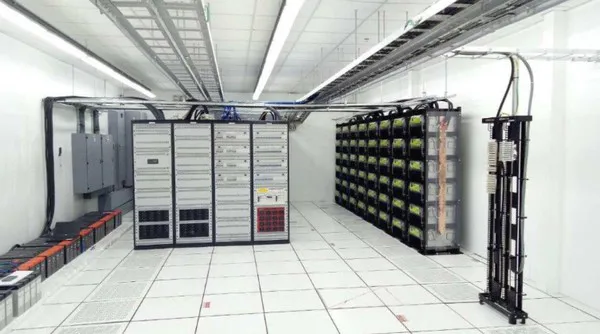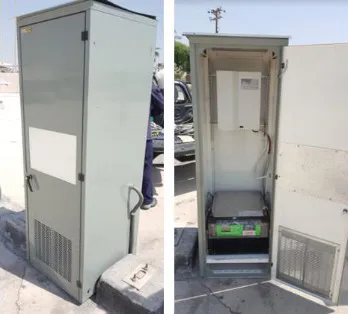Perhaps more than ever, growers are looking at the energy situation on their farms. This increasingly includes electricity storage in times of high energy prices. For this, growers already know how to find Durable M.E., a specialist in energy storage and battery systems. Yet Jean-Pierre Gödde was recently at a trade fair for the first time. He brought a salt battery to HortiContact. Not a new innovation, but still new to many growers.
What is special about the salt battery is that it basically contains just 'table salt.' "Yes, the salt you put on your egg," confirms the man from the company based in Goes. The core of the battery consists of compressed salt in a ceramic casing. There are no chemicals involved. The salt heats up, and that process allows the battery to retain and store energy. Unlike other salt batteries, it is thus not a heat storage battery.
The inside of the battery stays around 280 degrees Celsius on average. On the outside, due to an insulating alloy around the battery, there is not much of that. "If you hold your hand against the outside, the temperature is about 20 degrees Celsius," he says.

An average household can run well on the salt battery Jean-Pierre brought to HortiContact.
Long lifespan
Besides the lithium batteries in different shapes and sizes offered by Durable M.E., for Jean-Pierre, the salt battery is "surely the showpiece." He started offering the salt battery in 2022. There are several reasons for this. As a battery specialist, he can talk about it at length. "It is the future because the battery lasts longer, is safe because it is not a fire hazard, and is sustainable because it is a purely European product."
The salt battery comes from Switzerland. This is, in large part, the reason for the higher price than the lithium battery. "It is not a low-wage country, but a country that stands for quality," he says. It is precisely the price that often keeps people from choosing the salt battery at present, Jean-Pierre notes. "Many people still look at the short term. A lithium battery usually lasts ten years and is currently still around forty percent cheaper than the salt battery." The latter has a lifespan of up to 20 years, so the buyer still ends up spending less in the end. "This is because it lasts longer, and you can amortize the investment over a longer period. Moreover, a salt battery requires little maintenance."

Resistant to harsh conditions
When selling battery systems, Durable M.E. aims to 'get the bill to 0'. It does this by providing tailor-made solutions. This also involves the supply of an energy management system (crucial for optimal response to electricity market demands for grid balancing), an inverter, and connection to the grid, and (often) solar panels. "Installation is basically the same as with lithium batteries," he says.
However, there are fewer restrictions on using the salt battery. "You can confidently place the salt battery in a shed or barn or against the facade. For lithium batteries, they are sometimes required to go outside or are not even allowed within a minimum radius of buildings. The placement of lithium batteries requires a cooled space. Lithium batteries do not cope well with high or low temperatures. Ideally, it should not get hotter than 20 degrees Celsius and not colder than 5 degrees. Then cell damage can occur."
Scalable
With the salt battery, the biggest constraint is mainly physical. "We can actually supply anything, up to 20 megawatts or more. What we do is all scalable. For example, we deliver in 10-, 20- or 40-foot sea containers. The weight, about 40% heavier than a lithium battery, is still especially tricky for application in mobility." Jean-Pierre knows that research is now focused on getting the weight down. Nevertheless, the salt battery is already incidentally used in mobility. "In Norway, a bulldozer drives with such a battery as a counterweight. It is very cold there, but the battery can withstand that just fine."
The salt battery, although new to greenhouse farming, is no longer an innovation. "No, the battery has already been very heavily tried and tested abroad. The battery has been around for twenty-five years. It kind of started in Dubai. There, they store electricity to power city watering and lighting systems. In Mexico and Chile, there are salt batteries on plateaus. Anyway, Swiss test very extensively, so I have 100 percent confidence in that."
Battery is smart 
The first grower to actually work with the salt battery is coming. Of that, Jean-Pierre is certain. Interest was already there last year, and in talks at the fair also plenty from growers.
As mentioned, Durable M.E. also supplies an energy management system with its batteries. For greenhouse farming, CEMS, the name of the specific system for large farms, applies. "This is a very comprehensive system. You can use it to help balance the grid and receive compensation for it, day-ahead trading, where the best buying and selling prices are automatically determined from the battery storage, as well as simply using the battery for your own use."
Even then, the battery proves to be smart. "The battery is equipped with artificial intelligence that learns from the end user. The battery learns to recognize patterns, so based on the weather forecast and knowledge of exposure settings, for example, the battery responds accordingly by being full on time."
"A final point that might win over greenhouse growers in opting for the sustainable battery is that the salt battery can be used as an 'extension of grid capacity,' which is especially interesting if the grid is 'full.' It's like this, Jean-Pierre explains, "when installing a battery, a user can create their own energy system, making it possible, in case of a business expansion, to meet the extra electricity demand with a battery and solar panels. An additional (larger) cable from the road to the electricity box is then not needed."
For more information:
Jean-Pierre Gödde 
Durable M.E. B.V.
Fort Oriental 11
4463 AP Goes
Tel.: +31 (0)6 21 38 51 11
info@durableme.nl
www.durableme.nl
